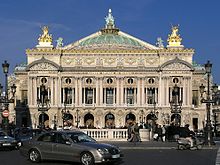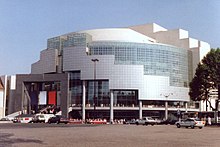Paris Opera

The Paris Opera (official name: Opéra National de Paris ) and its predecessor institutes play an important role in opera history with their style-defining world premieres. The institution of the Opéra has always been viewed as independent of its changing venues. Before the French Revolution (since 1669) it was called the Académie Royale de musique and was incorporated into the Académie Royale .
history
The Opéra was the official theater of the French court at the end of the 17th century (similar to the Comédie-Française for spoken drama). In contrast to the Comédie-Française, the Opéra did not receive any royal subsidies and had to cover some of its costs by renting out its privileges. Although it was extensively regulated by the king, the Opera Academy was initially a private business of the owner of the privilege he had conferred, but after the years of management by Lully it became consistently in deficit and needed the support of the city of Paris to add the Menus Plaisirs and thus part of it shortly before the revolution of the royal family. At the end of the 18th century, the Opéra-Comique was opened as an institution of a bourgeois counterculture to the Opéra. In the 19th century the nobility withdrew from the opera, and as a counterweight to the emerging genre of the opéra-comique , the grand opéra developed as a new and equally bourgeois pillar of the opéra. From the dance performances of the operas, which were always very important in France, the independent ballet developed here .
The Opéra exists as a “national” institution.
Locations
Current
The Opéra National de Paris uses two opera houses:
- The old opera, which opened on January 5, 1875, named Opéra Garnier or “Palais Garnier” after its architect , has been used mainly for ballet performances by the Ballet de l'Opéra de Paris and classical operas since the inauguration of the new opera house in 1989 . With an area of 11,237 m², the Opéra Garnier is the largest theater in the world, but is surpassed in the number of seats by the La Scala in Milan and the Vienna State Opera . This historic building is also the scene of the events in Gaston Leroux's classic horror novel The Phantom of the Opera .
- The new Opéra Bastille on Place de la Bastille was designed by the architect Carlos Ott . It was inaugurated on July 13, 1989, on the eve of the 200th anniversary of the storming of the Bastille .
Opened in 1875, the Opéra Garnier is one of the architectural sights of Paris. It has a capacity of 2150 spectators. The design of the staircase, the ballroom and the foyer shows the splendor of the Second Empire in perfection.
Since 1671
| Duration | building | Street |
|---|---|---|
| March 19, 1671 - March 30, 1672 | Jeu de Paume de la Bouteille | Rue des Fossées-de-Nesles (as Rue Jacques-Callot ) |
| November 15, 1672 - 1673 | Jeu de Paume du Bel-Air | Rue des Fossées-de-Nesles (as Rue de Médicis ) |
| June 16, 1673 - April 6, 1763 | Salle du Palais-Royal | Rue Saint-Honoré (between Rue de Valois and Rue des Bons-Enfants ). Destroyed by fire on April 6, 1763. |
| January 24, 1764 - January 23, 1770 | Salle des Tuileries | in the Tuileries between the Pavillon de l'Horloge and the Pavillon de Marsan . Destroyed by fire in May 1871. |
| January 26, 1770 - June 1781 | Salle du Palais-Royal | Rue Saint-Honoré (on the site of the theater that burned down in 1673, destroyed by fire in June 1781) |
| August 14, 1781 - October 1781 | Salle des Menus-Plaisirs (the former Salle de la Foire Saint-Laurent ) | Rue Bergère , demolished in 1910 |
| October 27, 1781 - August 1794 | Salle de la Porte Saint-Martin | Boulevard Saint-Martin (on the site of the later Théâtre de la Porte Saint-Martin ), destroyed by fire in May 1871 |
| August 7, 1794 - February 1820 | Salle Montansier | Rue de la Loi (as Square Louvois ), demolished 1820–1821 |
| April 19, 1820 - May 11, 1821 | Salle Favart ( Théâtre Italy ) | Rue Favart / Place Boieldieu (on the site of today's 3rd Salle Favart , venue of the Opéra-Comique ); on 13./14. Destroyed by fire January 1838. |
| May 15, 1821 - June 15, 1821 | Salle Louvois | Rue de Louvois , demolished in 1899 |
| August 16, 1821 - October 27, 1873 | Salle Le Peletier | Rue Le Peletier , on 27./28. Destroyed by fire in October 1873 |
| January 19, 1874 - December 30, 1874 | Salle Ventadour (Opéra Italy) | at the current location of the Banque de France |
| since January 5, 1875 | Opera Garnier | Place de l'Opéra |
| since July 13, 1989 | Opera Bastille | Place de la Bastille |
Important world premieres
- 1774 Iphigenie in Aulis by Christoph Willibald Gluck
- 1779 Iphigenie auf Tauris by Christoph Willibald Gluck
- 1828 La muette de Portici by Daniel-François-Esprit Auber
- 1829 Guillaume Tell by Gioachino Rossini
- 1831 Robert le diable by Giacomo Meyerbeer
- 1835 La Juive ( The Jewess ) by Jacques Fromental Halévy
- 1836 Les Huguenots ( The Huguenots ) by Giacomo Meyerbeer
- 1838 Benvenuto Cellini by Hector Berlioz
- 1840 La favorite by Gaetano Donizetti
- 1841 Giselle , ballet by Adolphe Adam choreographed by Jean Coralli and Jules Perrot
- 1847 Jérusalem first grand opéra by Giuseppe Verdi
- 1849 Le prophète by Giacomo Meyerbeer
- 1855 Les vêpres siciliennes by Giuseppe Verdi (as part of the first world exhibition )
- 1860 Le Papillon , ballet by Jacques Offenbach
- 1861 Tannhäuser (Paris version) by Richard Wagner
- 1865 L'Africaine by Giacomo Meyerbeer
- 1867 Don Carlos by Giuseppe Verdi
- 1868 Hamlet by Ambroise Thomas
- 1884 Manon by Jules Massenet
- 1885 Le Cid by Jules Massenet
- 1902 Pelléas et Mélisande by Claude Debussy
- 1910 L'Oiseau de feu ( The Firebird ), ballet performed by Sergei Pawlowitsch Djagilews Ballets Russes , music by Igor Stravinsky
- 1911 L'heure espagnole ( The Spanish Hour ) by Maurice Ravel
- 1927 Le pauvre matelot ( The Poor Sailor ) by Darius Milhaud
- 1947 Les mamelles de Tirésias ( The breasts of Tiresias ) by Francis Poulenc
- 1979 Lulu by Alban Berg (completed version by Friedrich Cerha)
- 1983 Saint François d'Assise by Olivier Messiaen
Important chief conductors
- Sir Georg Solti (1973–1974)
- Myung-whun Chung (1989-1994)
- James Conlon (1995-2004)
- From 2004 to 2009 there was no chief conductor at the opera
- Philippe Jordan (since 2009/10 season)
See also
Web links
- www.operadeparis.fr Website of the Paris Opera
- Marc Zitzmann: The greatest opera in the world. 350 years of Opéra de Paris , homepage of the "Frankfurter Allgemeine", June 28, 2019
Individual evidence
- ↑ Jérôme de La Gorce: L'Opéra à Paris au temps de Louis XIV. Histoire d'un théâtre , Paris 1992, p. 185.

